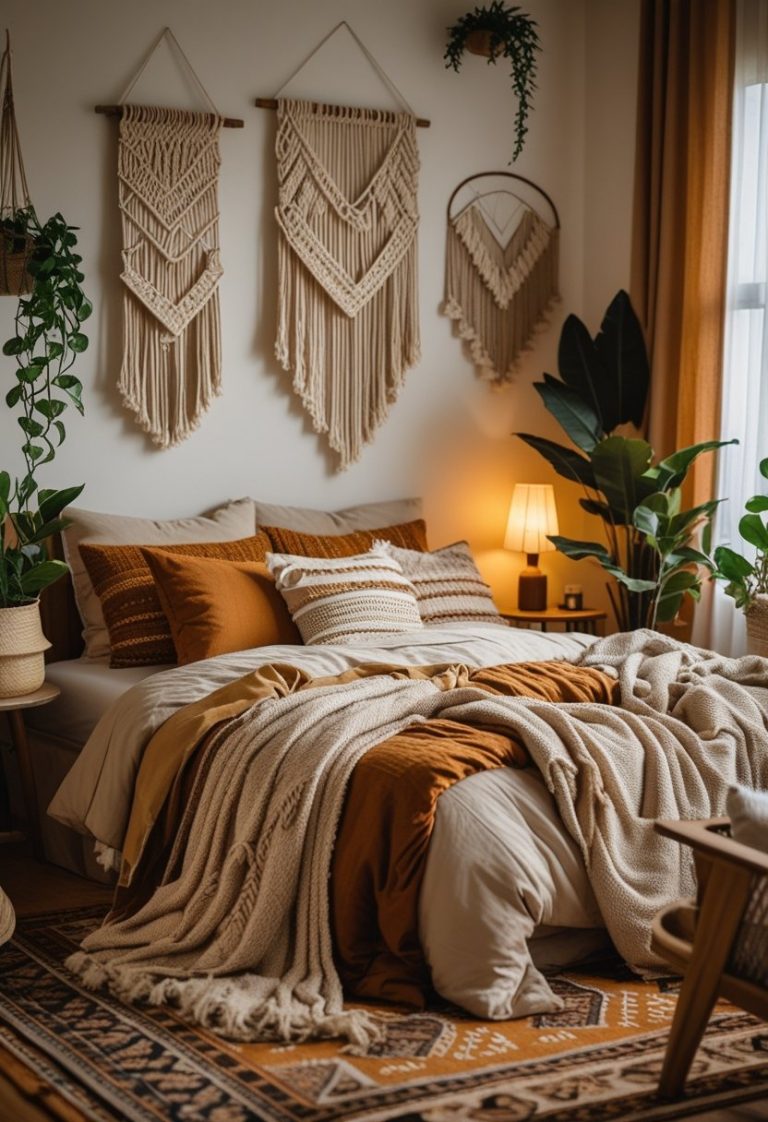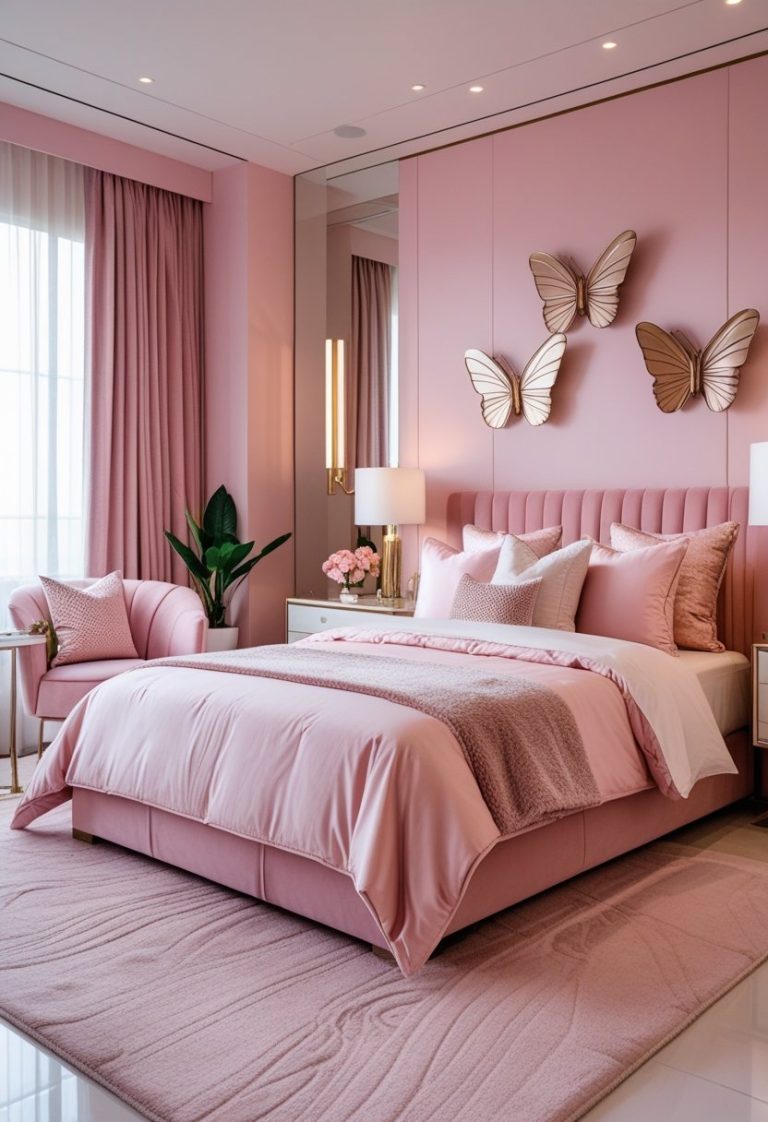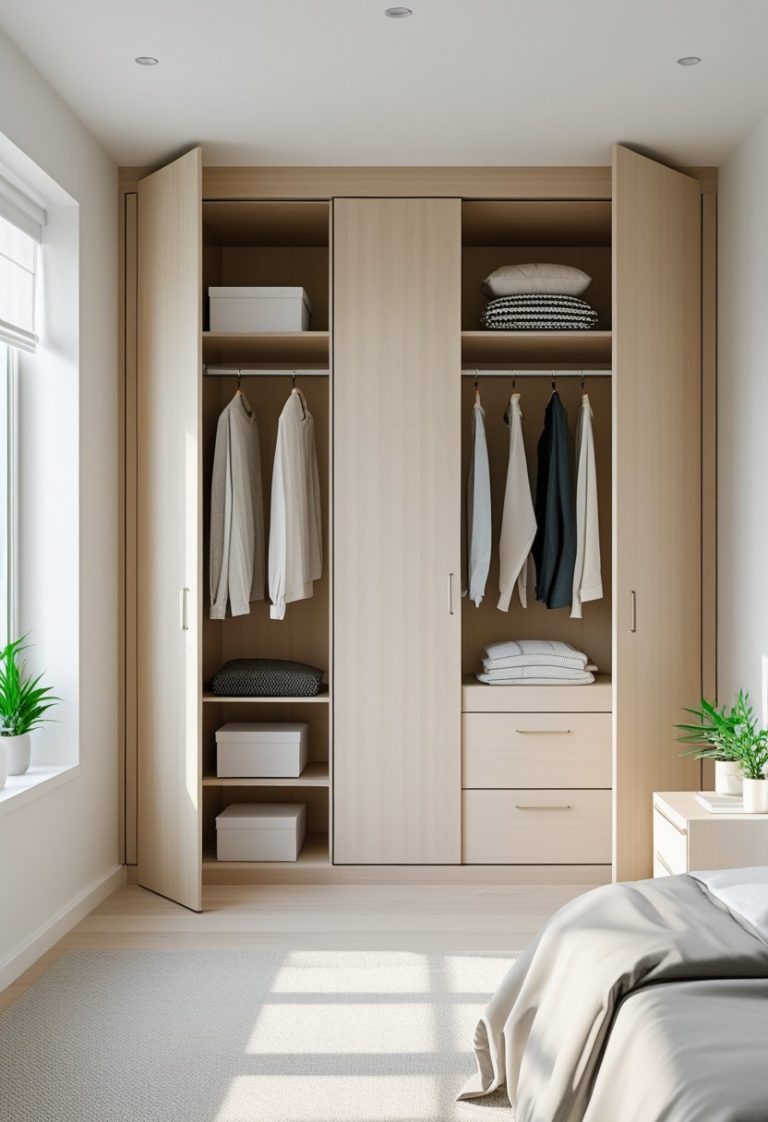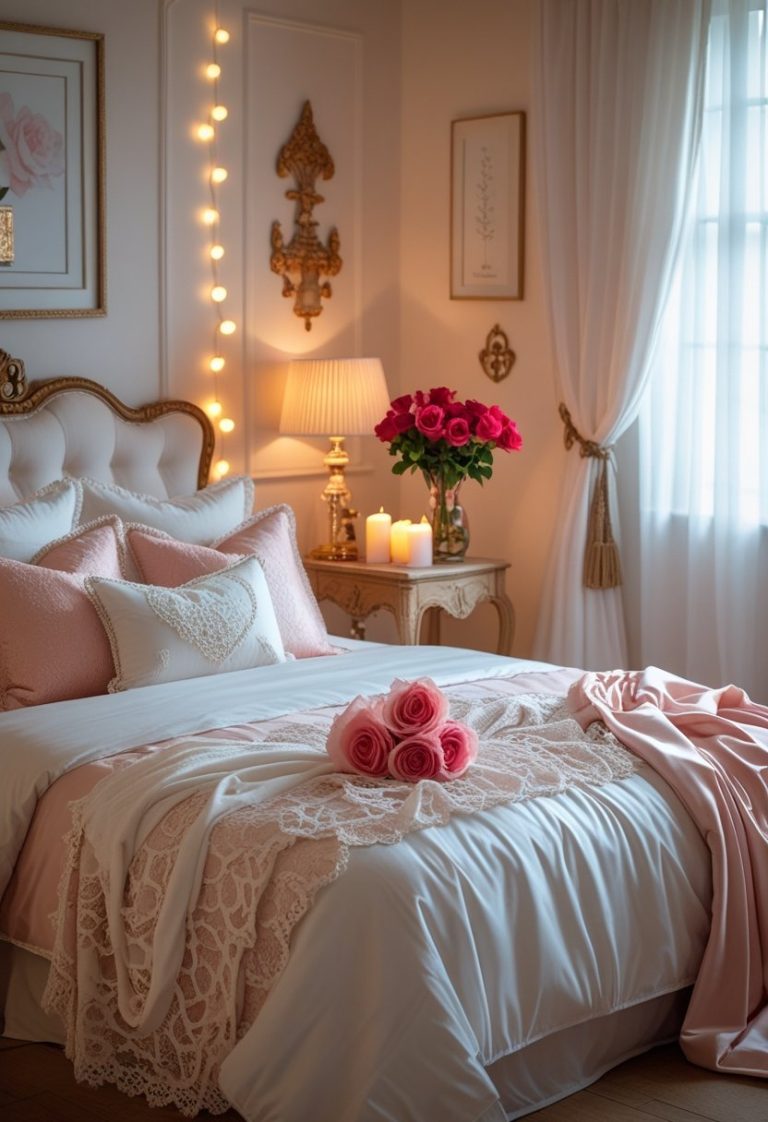Modern blue & white bedroom: serene, sleek, minimalist, refined style
A modern blue and white bedroom creates a space that feels both calm and sophisticated. The choice of blue tones adds depth and tranquility, promoting relaxation, while white elements introduce brightness and enhance the room’s clarity. This balance between the two colors is key to crafting a serene yet visually engaging environment.
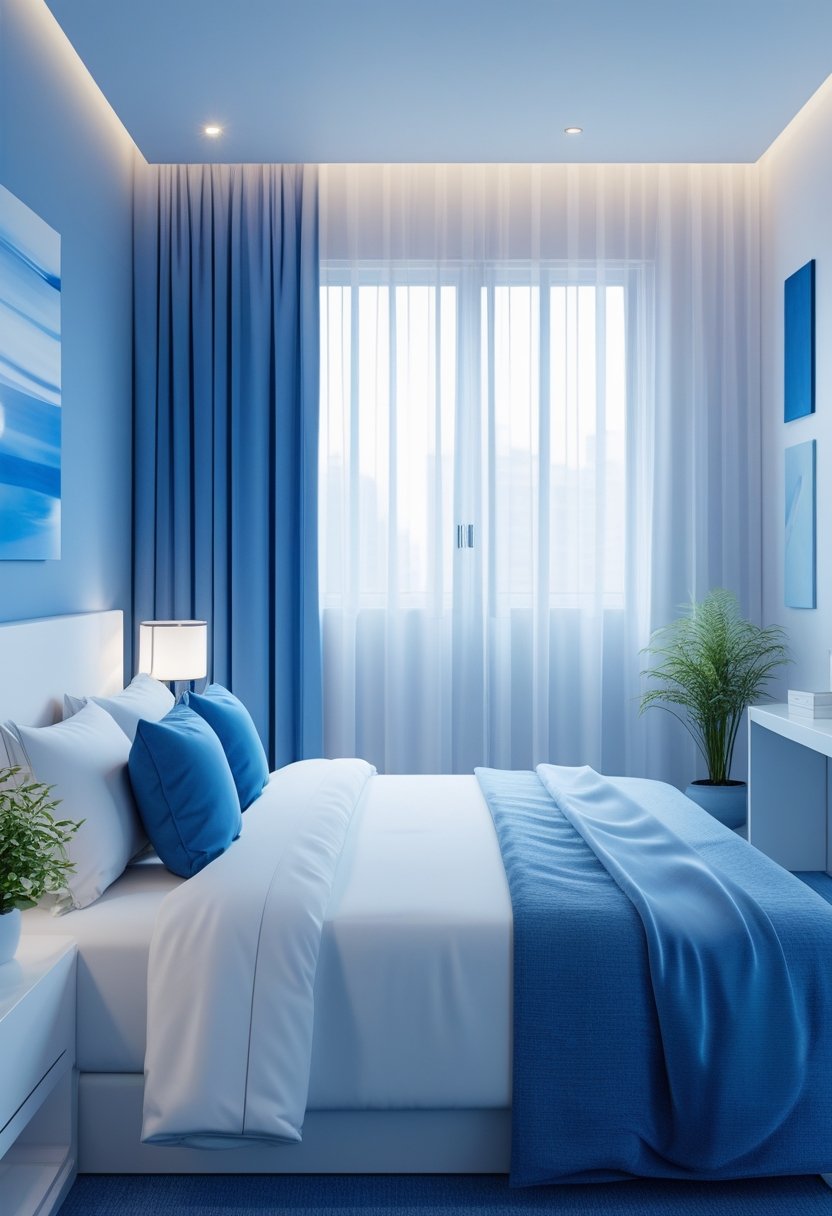
Minimalist design combined with thoughtful texture and lighting choices gives the room a refined, contemporary edge. The simplicity of clean lines and subtle contrasts allows the eye to rest, making the bedroom a peaceful retreat. Careful use of materials and illumination further enhances the sleek, modern aesthetic without clutter or distraction.
Key Elements of a Modern Blue and White Bedroom
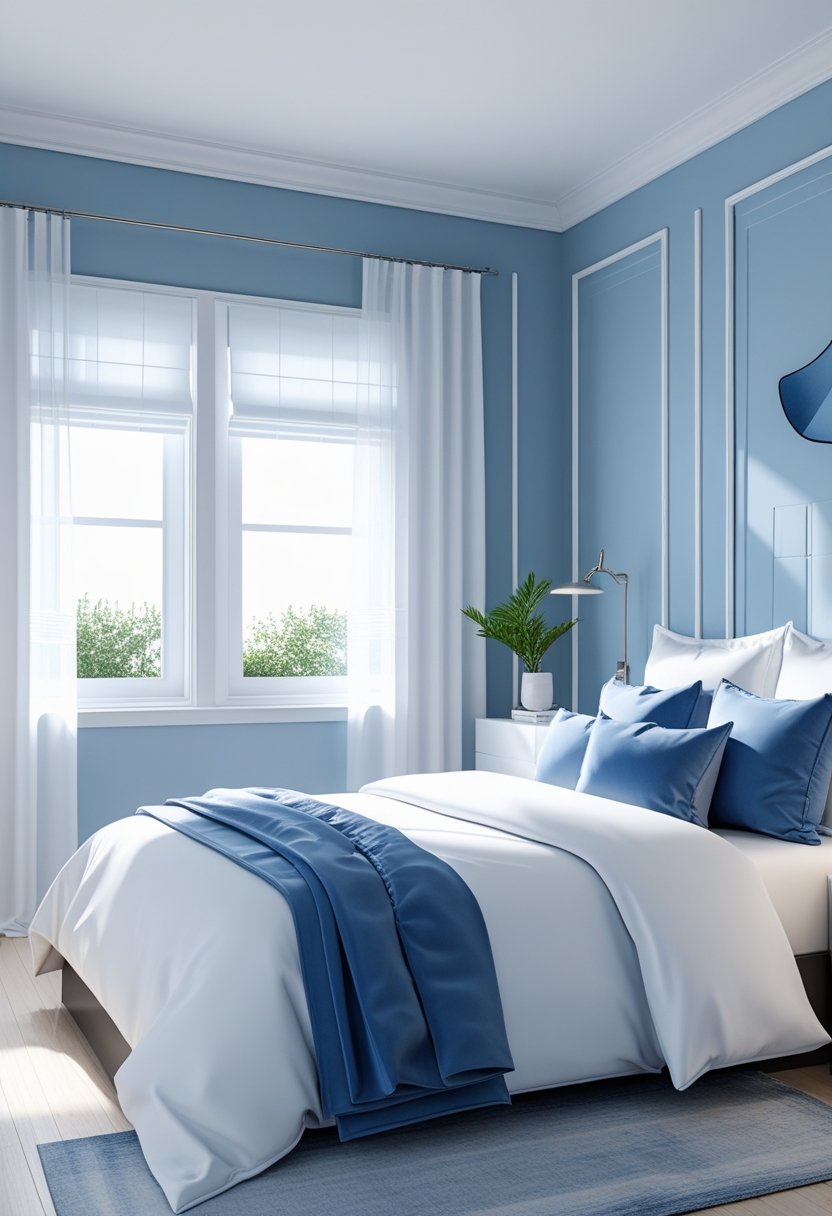
Creating a modern blue and white bedroom requires careful attention to color dynamics, design simplicity, and material choices. These elements work together to establish a space that feels both calming and sophisticated.
Color Palette and Contrast
The core of this bedroom design is a balanced blue and white palette. Deep or muted blue shades provide a sense of depth and calmness. White, in contrast, introduces brightness and clarity, preventing the room from feeling heavy or dark.
Using white walls or large white surfaces helps open the space visually. Blue appears in furniture, accent pieces, or textiles like pillows and throws to create focal points. The contrast between white and blue sharpens the room’s edges, enhancing a sleek, modern feel.
Incorporating varying shades of blue—from navy to soft sky blue—adds dimension without overcomplicating the palette. Silver or chrome finishes can elevate the contrast by reflecting light, contributing to the room’s refined atmosphere.
Minimalist Design Principles
Simplicity is fundamental. The design avoids clutter by limiting furniture to essential pieces with clean lines. The layout favors functionality and open space, allowing the colors and textures to stand out.
Furniture often features streamlined shapes, such as a plain blue bed frame against a white backdrop. Decorations are minimal and purposeful, such as a single piece of abstract art or a modern starburst clock.
Lighting fixtures should be understated yet effective. Recessed or track lighting softly illuminates the room without creating distractions. Natural light is maximized to enhance the room’s airy feeling.
Textural Layering for Sophistication
To avoid flatness, textures are layered thoughtfully. Smooth surfaces like lacquered dressers are balanced with softer textiles such as plush throws or linen bedding. This layering adds depth and tactile interest.
Patterns are kept subtle and restrained. Geometric blue shapes on white linens or a textured blue rug contribute visual complexity without overwhelming the serene quality of the room.
Material choices like natural wood flooring or woven baskets can add warmth. These textures ground the blue and white tones, making the space feel inviting rather than sterile.
Choosing and Using Blue Tones
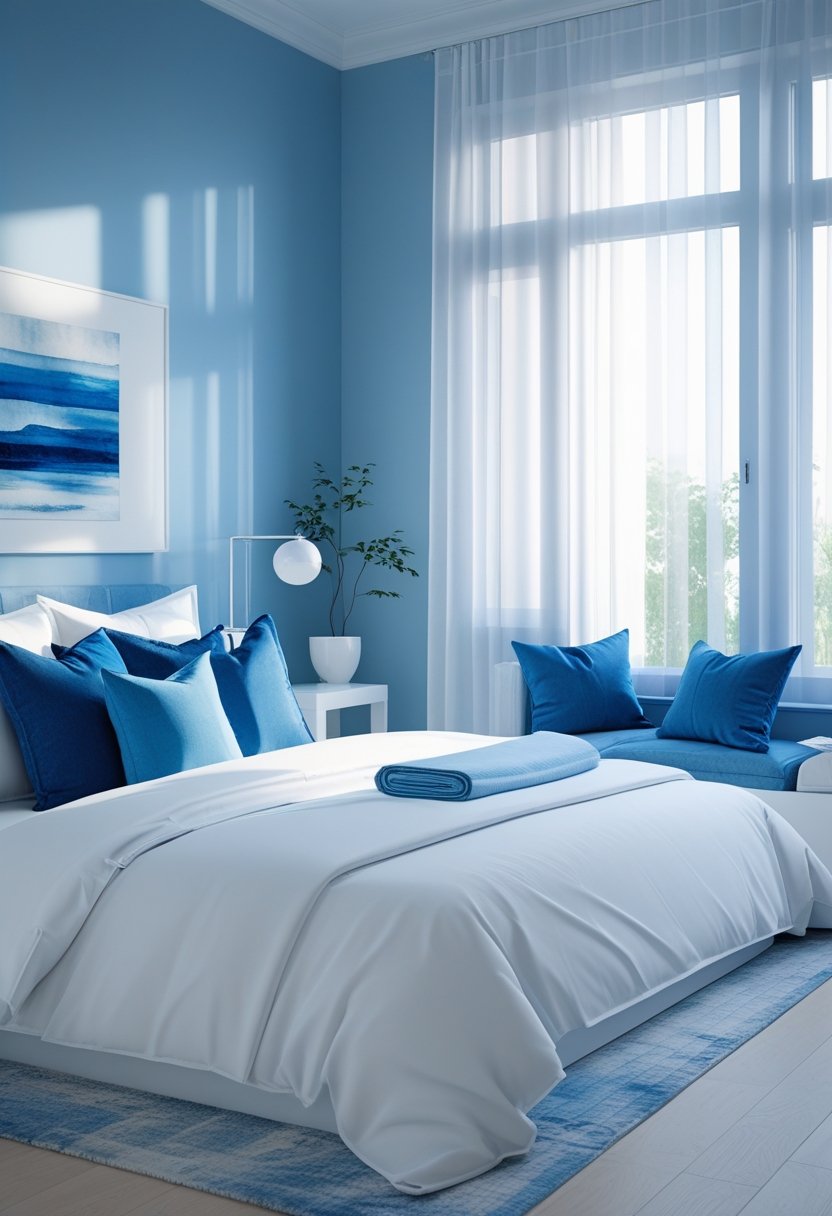
Careful selection of blue hues shapes the mood and style of a bedroom. Whether used as the main color or in accents, blue interacts with white to affect light and space perception. Effective choices consider shade, saturation, and the placement of blue elements to create calmness and visual interest.
Selecting Blue Hues for Calmness
Soft, muted blues such as powder blue or slate create a soothing atmosphere. These shades work well on larger surfaces because they reduce visual noise and promote relaxation. Darker blues like navy add depth and sophistication but should be balanced with lighter elements to avoid heaviness.
Choosing the right blue depends on the room’s natural light. Cooler blues reflect daylight and keep the space feeling fresh. Warmer blues with slight gray undertones can add warmth without compromising serenity. Testing paint samples in different lights is crucial before committing.
Applying Blue Accents and Features
Blue accents offer flexibility in design. Pillows, rugs, and artwork can introduce blue without overwhelming the room. Patterns such as geometric prints or stripes in blue and white add texture and visual layers.
Textured blue fabrics, like velvet or woven cotton, bring dimension and softness. Combining these with white furniture or bedding highlights the contrast. Lighting also enhances blue accents, especially when paired with warm, indirect lighting to soften intense colors.
Using Blue Walls as a Statement
Painting walls blue makes a bold statement and defines the room’s character. Lighter blues expand the space visually, ideal for smaller rooms. Dark blue walls create a cozy, enveloping feeling suited for larger bedrooms.
To keep the space balanced, pairing blue walls with white trim or ceilings maintains brightness. Incorporating natural materials like wood furniture complements blue walls, adding warmth. Blue walls also work well with minimal decor to maintain a sleek and modern look.
Enhancing Brightness with White
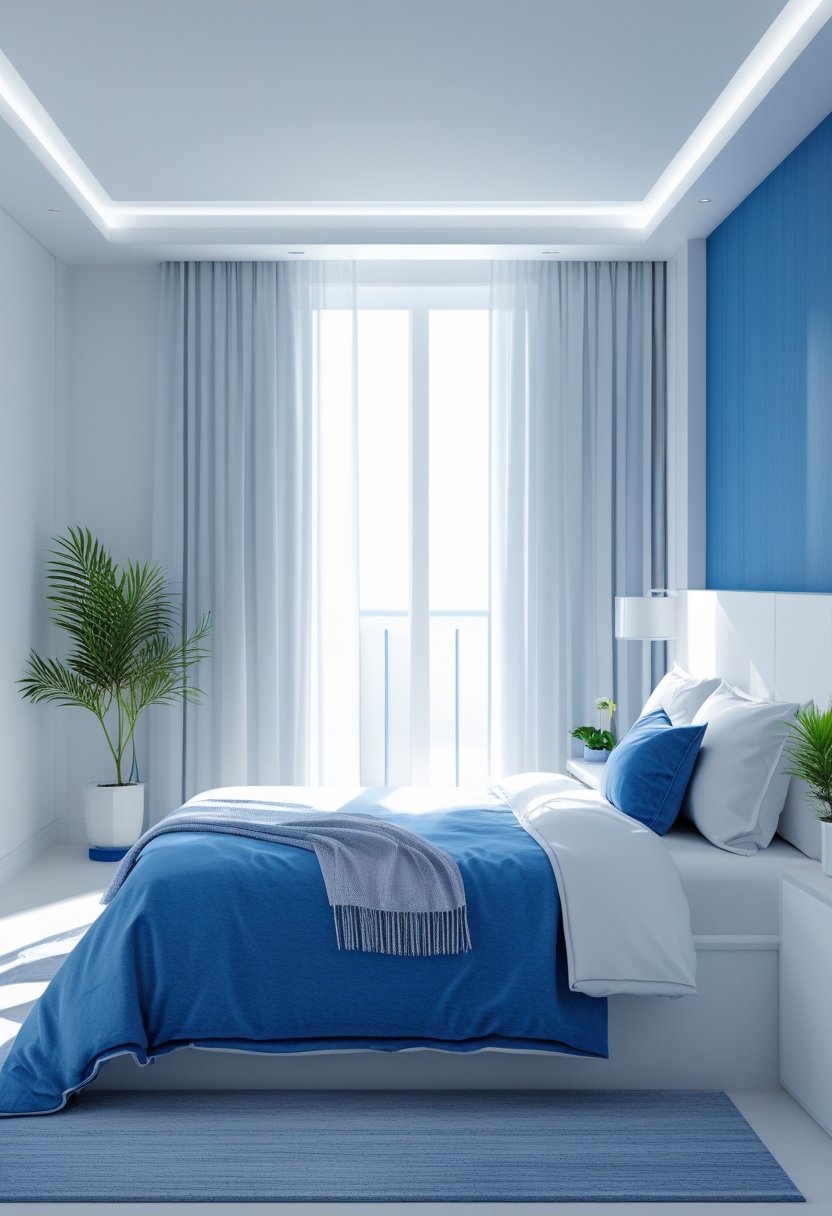
White plays a crucial role in increasing the sense of brightness and clarity in the bedroom. It works by reflecting natural and artificial light, helping to create an open, airy atmosphere. Strategic use of white in various elements can balance deeper blue tones without overwhelming the space.
Balancing Light and Color
White walls, ceilings, and trim are essential for maximizing light reflection. This enhances the calming blue shades by preventing the space from feeling too dark or enclosed. Proper lighting complements this balance—soft, warm white lights reduce harsh shadows, maintaining a serene bedroom ambiance.
In daylight, white surfaces reflect sunlight evenly, brightening corners and making the room feel larger. Combining matte and glossy white finishes adds subtle visual interest without detracting from the minimalist design. The mix supports a sleek, sophisticated look that keeps the space feeling fresh and inviting.
Benefits of White Furnishings
White furniture anchors the room with a clean, crisp foundation. Pieces like dressers, nightstands, or bed frames in white contribute to a cohesive, uncluttered aesthetic. Their neutral tone pairs effortlessly with diverse blue accents—from muted navy to powder blue—preserving a harmonious color scheme.
Durable, white-finished furniture is favored for its timeless quality. It allows bedroom decor to evolve with changing tastes without requiring major updates. Furthermore, white furnishings enhance the perception of space, crucial for bedrooms aiming for a serene, open feel.
Incorporating White Textiles
White textiles such as bedding, curtains, and rugs soften the room while boosting brightness. Crisp white sheets and pillowcases contrast beautifully with blue bedding or cushions, emphasizing cleanliness and restfulness. Light fabrics like linen or cotton maintain breathability, adding comfort.
Increased texture variety in white textiles helps avoid flatness. Layering smooth sheets with knit throws or embroidered pillows creates depth, enriching the sensory experience. This balance of simplicity and tactile contrast reinforces the serene bedroom vibe central to modern blue and white design.
Sophisticated Furniture and Focal Points
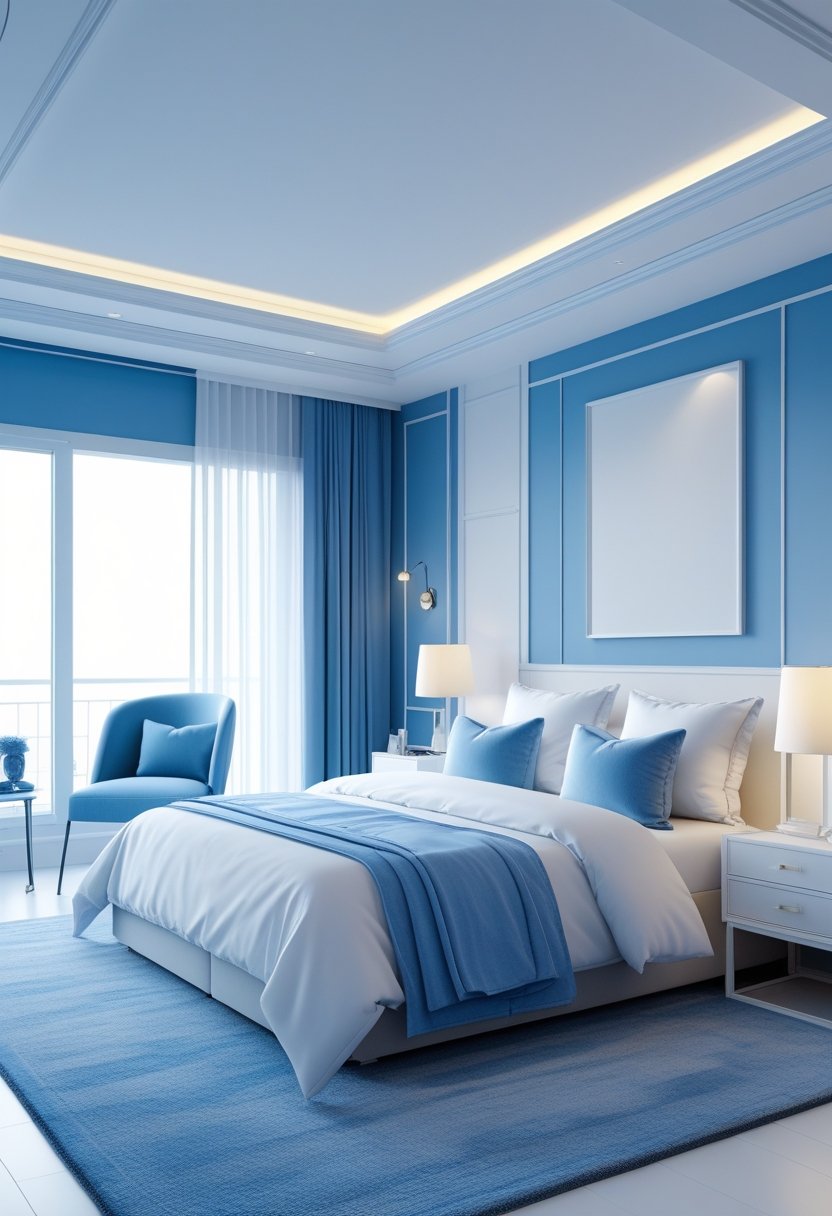
Careful selection of furniture and focal elements defines the bedroom’s modern aesthetic. The pieces emphasize clean lines and balanced proportions, while carefully chosen textiles anchor the color palette. Accents in blue enhance depth without overwhelming the clean, white backdrop.
Modern Bedroom Furniture Selection
Furniture with minimalist profiles sets the foundation for a sleek space. Low-profile beds, simple nightstands, and streamlined dressers in light wood or matte white finishes keep the room feeling open and airy. Materials like metal and glass can be incorporated selectively to add subtle contrast and sophistication.
Storage solutions integrate seamlessly through built-in cabinetry or under-bed drawers to minimize clutter. This supports the room’s calm environment. Functionality pairs with style when pieces avoid excessive ornamentation and focus on geometric precision.
Feature Blue Headboards
Blue headboards serve as a strong visual anchor, delivering both color and texture. Opting for upholstery in rich navy, royal blue, or muted pastel adds depth and luxury. Headboards in velvet or linen create tactile interest, complementing the minimalist furniture set.
Placing the headboard against a white or pale blue wall maximizes contrast and highlights the blue tone without darkening the room. Shapes range from rectangular to rounded, depending on the desired balance between formal and relaxed styles. The headboard becomes the core feature, balancing prominence with simplicity.
Incorporating Blue Bedding
Blue bedding ties the room together and maintains the serene atmosphere. Combining different shades of blue through sheets, duvet covers, and throw pillows adds dimension without clutter. Soft materials like cotton or linen enhance comfort and support restful sleep.
Patterns such as subtle stripes, geometric shapes, or white-on-blue prints introduce interest while keeping with the clean aesthetic. Layering white linens underneath or alongside blue pieces maintains brightness and prevents heaviness. This approach creates a cohesive, inviting space that feels polished and tranquil.
Patterns, Textures, and Decorative Accents
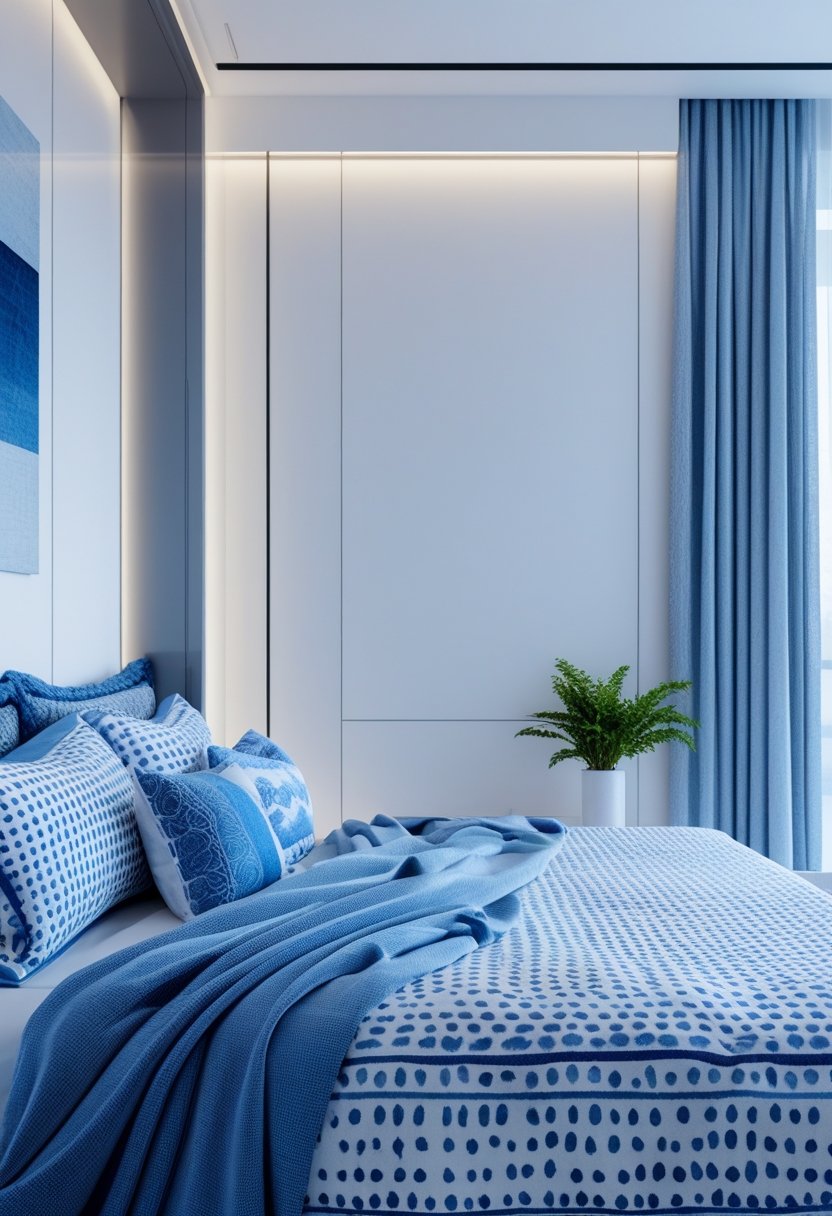
This modern blue and white bedroom draws on a balanced use of patterns, textures, and carefully chosen decorative elements. These components enhance visual interest and contribute to the room’s serene and sophisticated feel without overwhelming the minimalist design.
Mixing Patterns for Visual Interest
The bedroom incorporates a variety of blue and white patterns to create depth and character. Geometric shapes on linens and throw pillows add sharpness and structure. These are often paired with subtle stripes or dot motifs to break any monotony.
Mixing scale is key; larger patterns on a rug or duvet contrast with smaller patterns on cushions. This contrast prevents the room from feeling flat while maintaining a cohesive palette. Choosing patterns within the same color range ensures harmony and prevents visual clutter.
Adding Textured Layers
Texture introduces a tactile dimension that complements the smooth surfaces. In this space, fabrics such as linen, velvet, and cotton combine to build softness and warmth. A plush upholstered blue bed frame contrasts well with crisp white sheets while adding depth.
Textured accents like a woven throw or a subtly ribbed curtain bring richness, avoiding starkness. Matte finishes on furniture and lighting fixtures reduce glare, supporting a calming atmosphere. Thoughtful layering of textures invites comfort and sophistication.
Incorporating Blue Floral Motifs
Blue floral prints provide a timeless and classic touch to the bedroom. These motifs often appear on accent pillows, wallpapers, or artwork, linking the design to traditional aesthetics while remaining contemporary.
Delicate blue floral patterns against white backgrounds add elegance and softness without dominating the space. Using floral elements sparsely maintains the room’s clean lines. These accents offer a subtle nod to nature and history while enriching the color scheme.
Lighting and Final Touches

Lighting plays a critical role in enhancing the blue and white bedroom’s serene and sophisticated feel. Combining functional and ambient lighting with carefully selected textures and accessories completes the modern design while maintaining a calm atmosphere.
Choosing Lighting That Elevates the Design
Lighting should complement the color scheme by using cool whites or soft blues to amplify the room’s brightness without overpowering it. Layered lighting works best, starting with overhead fixtures that provide general illumination. Recessed or flush-mount ceiling lights maintain a minimalist aesthetic.
Accent lighting, such as wall sconces or LED strips in blue or white hues, adds subtle depth and reinforces the calming vibe. Adjustable bedside lamps with clean lines serve both practical and decorative purposes.
Natural light should also be maximized; sheer white curtains help maintain brightness while softening daylight. Using dimmers on lamps and overhead lighting enables easy control of mood and focus.
Finishing Details for a Contemporary Look
Textures like smooth linens, matte paint, and soft upholstery balance the sleekness of hard surfaces, fostering tactile interest without clutter. Minimalist artwork in blue and white tones or geometric patterns reinforces the modern theme.
Key finishing touches include metallic accents in brushed nickel or chrome, which highlight the polished, contemporary edge. Strategically placed mirrors amplify light and create the illusion of more space.
Accessories remain understated—think a simple vase, a subtle rug, or a single statement pillow—in shades that harmonize with the room’s palette. These details refine the space and ensure the design feels cohesive, fresh, and uncluttered.
Adapting Blue and White Bedrooms Across Styles

Blue and white bedrooms can be tailored to fit a variety of interior design styles by balancing color intensity, textures, and furnishings. Each approach highlights different qualities of the color scheme, from sleek minimalism to warm rustic elements or light, airy coastal vibes.
Minimalist and Modern Spaces
In minimalist blue and white bedrooms, the emphasis is on clean lines, uncluttered spaces, and subtle contrasts. White walls create a bright backdrop, while deep or muted blue tones add richness without overwhelming the room.
Textural variety is key. Smooth linens, matte finishes, or soft textiles bring visual interest without clutter. Lighting should be simple but effective, often using recessed lights or sleek fixtures to enhance the crisp palette. Furniture is streamlined, prioritizing function and form, with blue accents like an upholstered bed or geometric patterns on pillows.
This approach promotes calmness and sophistication while maintaining a contemporary feel. Minimal décor and strategic blue touches make the space feel open yet grounded.
Rustic Charm with Blue
Rustic blue and white bedrooms merge natural materials with the classic color pairing to evoke warmth and authenticity. Wooden furniture with distressed finishes or exposed beams contrasts with fresh white walls or linens.
Blue tones tend to be softer or muted, creating a cozy atmosphere alongside rustic textures like woven rugs, chunky knit blankets, or linen curtains. Accessories such as ceramic vases or vintage lamps enhance the comfortable, lived-in feel while keeping the palette balanced.
This style stresses tactile elements and organic shapes. It’s ideal for those wanting a peaceful retreat that combines blue’s calming effect with the inviting character of rustic design.
Coastal and Eclectic Inspirations
Coastal blue and white bedrooms emphasize lightness and openness by using pale blues paired with crisp, bright whites. Natural light is maximized, and airy fabrics like linen or cotton dominate the room.
Furniture often features whitewashed or weathered finishes, while blue appears in striped or abstract patterns on bedding and throw pillows. Nautical motifs or eclectic décor pieces, such as driftwood art or woven baskets, add personality without cluttering the space.
This style balances serenity with playful accents, appealing to those who want a fresh, breezy bedroom that reflects both relaxation and curated charm.

Ana Luisa
Explore in-depth biographies, net worth insights, and exclusive updates on your favorite singers at Trionua.com. Discover the journeys, achievements, and latest news about music’s biggest stars.

